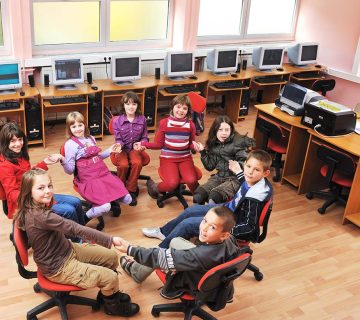Emotional awareness in children serves as a cornerstone for their social and psychological development. When children learn to identify, label, and understand their emotions, they gain the ability to manage their feelings, enhance empathy, and cultivate healthier relationships with peers and adults. This skill is especially crucial between ages 6 and 12, as it directly impacts academic success, inner peace, and constructive interactions. In this article, we explore the stages of emotional awareness development in children, influential factors, the roles of parents and teachers, and practical methods for teaching these skills—providing families and educators with a clear roadmap to foster children’s emotional growth.
1. The Importance of Emotional Awareness in Children
1.1. Defining Emotional Awareness
Emotional awareness encompasses the ability to recognize, name, and comprehend internal feelings. This process involves four key steps:
-
Emotion Identification: Recognizing, “What am I feeling right now?”
-
Emotion Labeling: Assigning the correct label—such as joy, sadness, anger, fear—to that feeling.
-
Understanding Emotion Causes: Identifying why the emotion arises, for instance, “I feel anxious because I haven’t finished my homework.”
-
Expression and Regulation: Appropriately expressing the emotion and employing strategies to manage it.
1.2. Benefits of Emotional Awareness
-
Better Behavior Management: Children who understand their emotions are less likely to act impulsively, pausing to think before reacting.
-
Enhanced Empathy and Social Relationships: Recognizing others’ emotions allows children to respond empathetically and build stronger friendships.
-
Increased Self-Esteem: Being able to understand and express emotions fosters a sense of worth, boosting confidence when children feel their feelings are acknowledged.
-
Improved Mental Health: Awareness and healthy management of emotions help prevent problems like anxiety and depression.
2. Stages of Emotional Awareness Development
2.1. Preschool and Early Elementary (Ages 3–6)
-
Basic Emotion Recognition: At this stage, children begin distinguishing primary emotions—like happiness and sadness—through visual tools (e.g., “emotion cards”) and storytelling by parents or teachers.
-
Early Labeling: A child might say “I am happy” or “I feel sad” but often cannot articulate precise reasons.
-
Nonverbal Expression: Many preschoolers rely on body language and facial expressions to show feelings, so caregivers should closely observe these cues.
2.2. Middle Elementary (Ages 6–9)
-
Broader Emotion Vocabulary: Children learn to identify more complex emotions such as embarrassment, jealousy, and pride.
-
Understanding Causes and Consequences: Their ability to link emotions to specific events grows—for example, “I feel lonely because my friend didn’t join me at recess.”
-
Improved Verbal Expression: Children begin talking about their feelings in full sentences, allowing them to describe situations in detail.
-
Emergence of Peer Comparison: They compare their emotions with classmates, considering questions like “How does my friend feel when they lose a game?” This comparison fosters empathy development.
2.3. Late Elementary (Ages 9–12)
-
Simultaneous Emotions: Preteens can experience mixed feelings—such as excitement and anxiety before a test—and must learn that these combinations are normal.
-
Internal Reasoning: They start reflecting on how external pressures—from grades to friendships—influence their feelings; e.g., “If I don’t do well on the quiz, I’ll feel disappointed, but if I ask my teacher for help, I’ll feel more hopeful.”
-
Acceptance of Individual Differences: By this age, children recognize that each person has a unique emotional style; one peer might feel excited playing sports, while another feels nervous.
3. Factors Influencing Emotional Awareness
3.1. Family’s Role
-
Parental Modeling: When parents demonstrate healthy emotional behaviors—encouraging emotional conversations and showing empathy—children learn by example.
-
Open Communication: A home environment where family members freely discuss feelings provides a safe space for children to explore their emotions.
-
Validation and Acceptance: Phrases like “It’s okay to feel that way” teach children that their emotions are valid and need not be suppressed.
3.2. School and Teachers’ Role
-
Formal SEL Instruction: Integrating Social-Emotional Learning (SEL) programs with group activities, storytelling, and role play helps accelerate emotional awareness.
-
Constructive Feedback: Teachers who help children analyze why they feel upset or joyful strengthen their ability to reflect on feelings.
-
Supportive Classroom Climate: Creating a nonjudgmental environment where students feel safe expressing emotions fosters emotional growth.
3.3. Individual Factors
-
Temperament and Personality: Some children are naturally calmer, while others are more sensitive. These differences affect how quickly they develop emotional skills.
-
Previous Experiences: Children who have faced emotionally challenging situations—such as family conflict or social exclusion—may struggle to identify or correctly express feelings.
-
Language Skills: A broader emotional vocabulary allows children to more precisely name complex feelings.
4. Signs of Inadequate or Misaligned Emotional Awareness
4.1. Inability to Label Emotions
A child who cannot say “I feel sad” or “I am angry” might resort to aggression or withdrawal. Parents and teachers should encourage labeling by asking, “How do you feel right now?” or “Why did you stop playing?”
4.2. Impulsive Reactions
When a child cannot pinpoint the cause of anger or sadness, they might shout, cry, or throw objects. Teaching techniques—like counting to ten or taking a deep breath before reacting—helps build self-regulation.
4.3. Lack of Empathy
If a child fails to recognize a friend’s sadness, they may unknowingly repeat hurtful behaviors. This indicates a gap in recognizing others’ emotional states, requiring guided empathy-building exercises.
4.4. Emotion Denial or Suppression
Persistent denial of negative emotions (e.g., saying “I’m fine” when clearly upset) can lead to deeper issues such as anxiety or depression. Creating a safe space for daily conversations—“Tell me one thing that made you feel happy or sad today”—can alleviate suppression.
5. Practical Strategies and Activities to Foster Emotional Awareness
5.1. Games and Group Activities
-
Emotion Cards Game:
-
Use cards with faces depicting different emotions (happy, sad, scared, angry). Children choose a card that best represents how they feel or what they believe a classmate is feeling.
-
Objective: Improve facial cue recognition and emotion labeling.
-
-
Feelings Wheel Activity:
-
A wheel divided into emotion segments (e.g., excited, frustrated, lonely). The teacher spins the wheel, and the child describes a time they felt that emotion.
-
Objective: Practice precise labeling and contextual understanding of emotions.
-
-
Role Play Scenarios:
-
Children act out everyday situations (e.g., arguing over a toy or winning a game). Peers guess the emotions.
-
Objective: Cultivate perspective-taking and empathetic responses.
-
5.2. Individual and Home-Based Activities
-
Emotion Journal:
-
Each evening, the child writes down one primary emotion they felt during the day and a sentence explaining why.
-
Objective: Strengthen self-awareness and writing skills.
-
-
Emotion-Themed Storybooks:
-
Read stories where characters experience various emotions. Afterward, parents or teachers ask questions like, “How did the character feel when they lost their toy?”
-
Objective: Learn emotion recognition through narrative and character analysis.
-
-
Mirror of Emotions:
-
The child stands before a mirror and mimics different emotional expressions (e.g., frowning for sadness, wide eyes for surprise). The adult labels each emotion.
-
Objective: Align facial expressions with internal feelings.
-
5.3. Linking to Emotion Regulation Skills
-
Deep Breathing Exercises:
-
When feeling angry or scared, instruct the child to inhale slowly for four seconds, hold for four seconds, then exhale for four seconds. This practice lowers heart rate.
-
Objective: Provide a concrete tool connecting emotion recognition to calming physiology.
-
-
Calming Strategy Cards:
-
Create cards with brief activities (e.g., “Stretch for 5 minutes,” “Draw a quick doodle,” “Take a 5-minute walk,” “Listen to soft music”). The child selects and performs one when upset.
-
Objective: Teach constructive coping strategies.
-
-
I-Message Communication:
-
Model how to say, “When you…, I feel… because…” For example, “When you took my crayon, I felt sad because I wanted to finish my drawing.”
-
Objective: Promote respectful and effective emotional expression.
-
6. The Roles of Parents and Teachers in Nurturing Emotional Awareness
6.1. Parents’ Role
-
Active Listening and Empathy:
-
When a child shares feelings, respond with empathetic statements like, “I understand you feel upset.” This affirms their emotional experience.
-
-
Encouraging Emotional Expression:
-
Praise children for naming and talking about their feelings: “Great job telling me you’re frustrated.”
-
-
Modeling Emotion Expression:
-
Parents openly share their own emotions: “When I saw that kind message, I felt really happy.” Demonstrating emotion expression normalizes the process.
-
-
Creating a Safe Family Space:
-
Dedicate regular family time—like dinner or a walk—where everyone can share daily emotional highs and lows.
-
6.2. Teachers’ Role
-
Integrating Emotion Activities in Daily Routines:
-
Reserve a few minutes each day for emotion-based activities—such as emotion cards or feelings wheel—to reinforce skills.
-
-
Constructive Emotional Feedback:
-
When a student expresses feelings, validate them: “It makes sense you’re nervous about the test.” This builds emotional confidence.
-
-
Teaching Emotional Vocabulary:
-
Introduce one or two new emotion words per week using stories, games, or group discussions. For example, “This week, let’s talk about ‘jealousy.’”
-
-
Promoting Cooperative and Empathetic Classroom Culture:
-
Design collaborative projects where students discuss how they might support a classmate who’s feeling down; e.g., “How can we help a friend who’s struggling in math?”
-







